September 18, 1855 – First U.S. Oil Company reorganizes –
In need of more capital, George Bissell and partner Jonathan Eveleth reorganized their New York-based Pennsylvania Rock Oil Company — America’s first oil exploration company — into the Seneca Oil Company of New Haven, Connecticut. They continued to seek investors for drilling a well to produce oil that could be refined into kerosene.
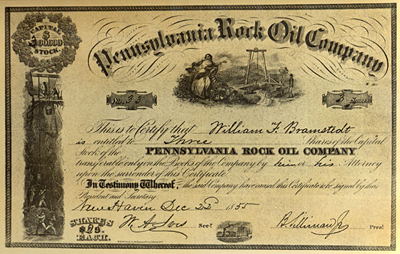
America’s first oil company, Pennsylvania Rock Oil Company, reorganized as Seneca Oil Company of New Haven Connecticut in 1858, one year before drilling the first U.S. Well.
The Pennsylvania Rock Oil Company had been established in 1854 to drill a well near Titusville (see George Bissell’s Oil Seeps). The re-incorporated business replaced New York City’s capital markets, which had shown little interest in drilling for oil, seen as too speculative.
Seneca Oil hired former railroad conductor Edwin L. Drake, who overcame financial and technical obstacles to complete the first U.S. oil well in August 1859.
September 18, 1948 – Oil discovered in Utah
J.L. “Mike” Dougan, president of the Equity Oil Company, completed Utah’s first significant oil well. Dougan’s small company outcompeted larger and better financed exploration companies, including Standard Oil of California (Socal), Pure Oil, Continental, and Union Oil. His Uinta Basin oilfield discovery launched a deep-drilling boom in Utah.
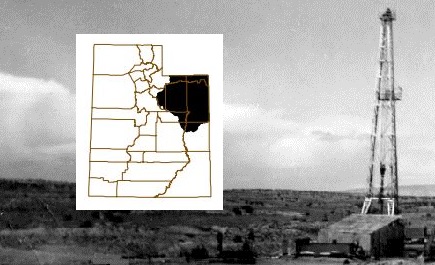
Begun in 1948 in the giant Uinta Basin, Utah’s petroleum industry continues today thanks to reserves of coalbed methane gas.
Unlike earlier attempts, Dougan drilled beyond the typical depth of up to 2,000 feet. His Ashley Valley No. 1 well, 10 miles southeast of Vernal, produced 300 barrels of oil a day from about 4,000 feet.
Uinta Basin production soon averaged almost one million barrels of oil a year from 30 wells. As drilling technologies advanced, companies began drilling to 8,000 feet and deeper.
Learn more in First Utah Oil Wells.
September 21, 1901 – First Louisiana Oil Well
Nine months after the headline-making January 1901 “Lucas Gusher” in Texas, another giant oilfield was revealed 90 miles east in Louisiana. W. Scott Heywood — already successful thanks to wells drilled at Spindletop Hill — completed a wildcat well that produced 7,000 barrels of oil a day well on the farm of Jules Clement.
Drilled six miles northeast of Jennings, the Clement No. 1 found oil at a depth of 1,700 feet. “The well flowed sand and oil for seven hours and covered Clement’s rice field with a lake of oil and sand, ruining several acres of rice,” noted the Jennings Daily News.

Mrs. Scott Heywood unveiled a marker as part of the Louisiana Golden Oil Jubilee in 1951. Times Picayune (New Orleans) image courtesy Calcasieu Parish Public Library.
The discovery led to the state’s first commercial oil production by opening the prolific Jennings field, which Haywood further developed by building pipelines and storage tanks. As the oilfield reached peak production of more than nine million barrels of oil in 1906, more discoveries arrived in northern Louisiana.
Learn more in First Louisiana Oil Wells.
September 22, 1955 – End of Signal Oil’s “The Whistler” Radio Program
Sponsored since 1942 by the largest independent oil company on the West Coast, the last episode of the radio drama “The Whistler” aired on CBS Radio. Signal Oil Company had been established in 1921 by Samuel Mosher as Signal Gasoline Company during California’s Signal Hill oil boom.
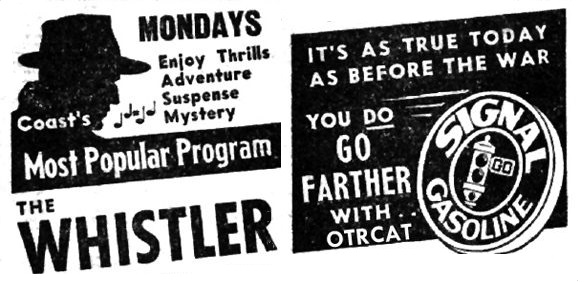
Signal Oil Company sponsored a CBS Radio mystery program beginning in 1942.
The company’s 1931 partnership with Standard Oil of California (Socal) led to sponsorship of many radio programs, according to Media Heritage. The 692 episodes of Signal Oil’s weekly radio mystery began with echoing footsteps and an eerie whistle, followed by “That Whistle is your signal for the Signal Oil program.”
September 23, 1918 – Giant Wood River Refinery goes Online
Roxana Petroleum Company’s Wood River (Illinois) facility began refining crude oil. It processed more than two million barrels of oil from Oklahoma oilfields in its first year of operation.
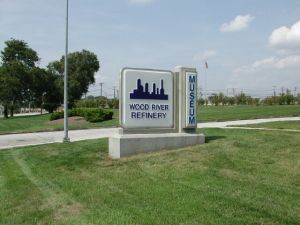
The Wood River Refinery History Museum is in front of the Phillips 66 Refinery southeast of Roxana, Illinois.
Roxana Petroleum Company was the 1912 creation of the Royal Dutch/Shell Group, which founded the American Gasoline Company in Seattle to distribute the fuel on the West Coast.
Roxana Petroleum was established in Oklahoma to produce high-quality oil to be refined at the Wood River plant. In West Texas, the company in 1928 built an experimental oil storage reservoir (see Million Barrel Museum).
Today, the Wood River 2,200-acre refinery at Roxana northeast of St. Louis is the largest owned by Phillips 66.
Visit the Wood River Refinery History Museum.
September 23, 1933 – Standard Oil of California Geologists visit Saudi Arabia
Invited by Saudi Arabian King Abdel Aziz, geologists from Standard Oil Company of California arrived at the Port of Jubail in the Persian Gulf. Searching the desert for petroleum and “kindred bituminous matter,” they discovered a giant oilfield. The Saudi Arabia and Standard Oil partnership would become the Arabian American Oil Company (Aramco), later joined by other major U.S. companies.
September 23, 1947 – New Patent for “Hortonspheres”
Horace E. Horton’s Chicago Bridge & Iron Company (CB&I) received a patent for improvements to a spherical storage vessel he had invented in the 1920s. Designed to efficiently store natural gas, butane, propane and other volatile petroleum products, the large spheres were among the most important storage innovations to come to the U.S. oil and natural gas industry.
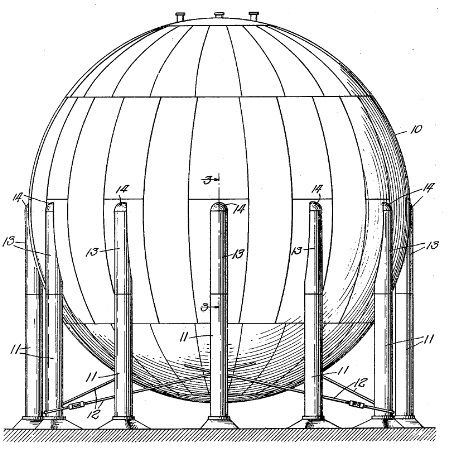
Horace Ebenezer Horton (1843-1912) founded the company that would build the world’s first “field-erected spherical pressure vessel.”
CB&I named its “Hortonspheres” after the engineer who had started the company in 1889 to build bridges across the Mississippi River. In 1892, CB&I erected its first elevated water tank in Fort Dodge, Iowa.
“The elevated steel plate tank was the first built with a full hemispherical bottom, one of the company’s first technical innovations,” CB&I noted, adding that company built, “the world’s first field-erected spherical pressure vessel” in 1923 at Port Arthur, Texas.
Learn more in Horace Horton’s Spheres.
September 24, 1951 – Perforating Wells with Bazooka Technology
When World War II veteran Henry Mohaupt applied to patent his “Shaped Charge Assembly and Gun,” he brought anti-tank technology to the petroleum industry — a downhole bazooka.
Mohaupt, a Swiss-born chemical engineer, during the war had conducted a secret U.S. Army program to develop an anti-tank weapon. His idea of using a conically hollowed out explosive charge to focus detonation energy led to the rocket grenade used in bazookas.

The patented “Shaped Charge Assembly and Gun” of Henry Mohaupt brought to the oil patch his highly successful anti-tank “bazooka” technology of World War II.
After the war, the potential of these downhole rocket grenades to facilitate flow from oil-bearing strata was recognized by the Well Explosives Company of Fort Worth, Texas. The company employed Mohaupt to develop new technologies for safely perforating cement casing and pipe.
Learn more in Downhole Bazooka.
_______________________
Recommended Reading: Myth, Legend, Reality – Edwin Laurentine Drake and the Early Oil Industry (2009); Utah Oil Shale: Science, Technology, and Policy Perspectives
(2016); Louisiana’s Oil Heritage, Images of America
(2012); Signal Hill, California – Images of America
(2006); Handbook of Petroleum Refining Processes
(2016); The Bazooka
(2012). Your Amazon purchase benefits the American Oil & Gas Historical Society. As an Amazon Associate, AOGHS earns a commission from qualifying purchases.
_______________________
The American Oil & Gas Historical Society (AOGHS) preserves U.S. petroleum history. Become an AOGHS annual supporting member and help maintain this energy education website and expand historical research. For more information, contact bawells@aoghs.org. Copyright © 2023 Bruce A. Wells. All rights reserved.


